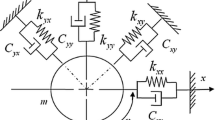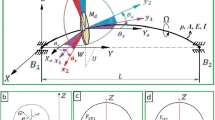Abstract
Rotordynamic analysis in complex coordinates has many advantages. Especially, the Lee diagram, with the concept of the infinity norm in directional frequency response matrix, can an effective design tool for rotating machinery, because the severity of the mode is clearly identified, and it also includes the concept of the worst case response prediction. However, it is not widely used in the field because most of the previous studies and commercial software are based on the real coordinate system. Our objective was to apply the Lee diagram to analyze rotordyanmic characteristics of the power turbine, which is a typical example of turbomachinery. We show that this could be a useful design tool for rotating machinery. The power turbine in this study was used for the super critical carbon dioxide power generation system and the rotor was supported by tilting pad bearings. The equation of motion of the rotor and bearing system was derived in the complex coordinate system. The Lee diagram was calculated with the concept of the infinity norm and unbalance response was predicted. The operation test of the power turbine was done with compressed air, and the rotor vibration was measured with the proximity probes. The results of the analysis show that the resonance speed can be effectively estimated with the Lee diagram and the degree of the anisotropy of the system can be identified. The operation test was done successfully and the measured maximum rotor vibration was about 5 μm. In addition, the measured rotor vibration shows that the anisotropy of the power turbine is very small as predicted, and the predicted vibration amplitude shows good agreement with the test data.
Similar content being viewed by others
Abbreviations
- A,B :
-
System matrix in generalized state-space form
- C :
-
Damping matrix
- f(t):
-
Force vector
- f x(t), f y(t):
-
Force components in the real coordinates
- G(jω):
-
Fourier transformation of g(t)
- g(t):
-
Force vector in the complex coordinates
- H(jω):
-
Frequency response matrix
- K :
-
Stiffness matrix
- M :
-
Mass matrix
- P(jω):
-
Fourier transformation of p(t)
- p(t):
-
Response vector in the complex coordinates
- q(t):
-
Response vector
- r :
-
Eigen vector in state-space form
- u :
-
Modal vector
- v :
-
Adjoint vector
- w :
-
State vector
- x(t), y(t):
-
Displacement components in the real coordinates
- λ :
-
Eigen value
- η :
-
Principal coordinates
References
J. S. Rao, Rotor Dynamics, New Age International Publishers (1996).
W. E. Campbell, The protection of steam turbine disk wheels from axial vibration, Transaction of ASME, 46 (1924) 31–160.
S. H. Crandall, Rotordynamics, Nonlinear Dynamics and Stochastic Mechanics, W. Kliemann and N. S. Namachchivaya (Ed.), CRC Press, Boca Raton (1995).
H. D. Nelson and S. H. Crandall, Analytic prediction of rotordynamic response, Handbook of Rotordynamics, F. F. Ehrich (Ed.), McGraw-Hill (1992) Chapter 2.
M. P. Singh, SAFE, Technology Report ST 16, Dresser-Rand Company (1984).
M. P. Singh and J. J. Vargo, Reliability evaluation of shrouded blading using the SAFE interference diagram, J. of Engineering for Gas Turbine and Power, 111 (1989) 601–609.
C. W. Lee, A complex modal testing theory for rotating machinery, Mechanical Systems and Signal Processing, 5(2) (1991) 119–137.
C. W. Lee, Vibration Analysis of Rotors, Kluwer Publishers (1993).
C. W. Lee, D. J. Han, J. H. Suh and S. W. Hong, Modal analysis of periodically time-varying linear rotor systems, J. of Sound and Vibration, 303 (2007) 553–574.
C. W. Lee and D. J. Han, Strength of modes in rotating machinery, J. of Sound and Vibration, 313 (2008) 268–289.
C. W. Lee and Y. H. Seo, Enhanced campbell diagram with the concept of h in rotating machinery: Lee diagram, J. Applied Mechanics, 77 (2010) 021012.
C. W. Lee and Y. D. Joh, Excitation methods and modal parameter identification in complex modal testing of rotating machinery, International J. of Analytical and Experimental Modal Analysis, 8 (1993) 179–203.
C. Y. Joh and C. W. Lee, Use of dFRFs for diagnosis of asymmetric/anisotropic properties in rotor-bearing system, J. of Vibration and Acoustics, 118 (1996) 64–69.
C. W. Lee and K. S. Kwon, Identification of rotating asymmetry in rotating machines by using reverse directional frequency response functions, Proceedings of Institution of Mechanical Engineers Part C, 215 (2001) 1053–1063.
V. Dostal, A supercritical carbon dioxide cycle for next generation nuclear reactors, Ph.D. Thesis, Massachusetts Institute of Technology (2004).
C. Turchi, Z. Ma and M. Wagner, Thermodynamic study of advanced supercritical carbon dioxide power cycles for concentrating solar power systems, J. of Sol. Energy Eng., 135 (2013) 041007.
P. Huck, S. Freund, M. Lehar and M. Peter, Performance comparison of supercritical CO2 versus steam bottoming cycles for gas turbine combined cycle applications, The 5th International Symposium — Supercritical CO 2 Power Cycles, San Antonio, Texas, March 28–31 (2016).
D. Lee, K. Sun, B. Kim and D. Kang, Thermal behavior of a worn tilting pad journal bearing: Thermohydrodynamic analysis and pad temperature measurement, Tribology Transactions, 61 (2018) 1074–1083.
Acknowledgments
This work was supported by the Korea Institute of Energy Technology Evaluation and Planning (KETEP) Grants No. 20182010106640 (Development of an energy saving 1,000 HP VSD turbo air compressor) and 20163030024510 (Development of a condition monitoring and diagnosis system for wind turbine generator system) funded by the Ministry of Trade, Industry & Energy (MOTIE) of the Republic of Korea.
Author information
Authors and Affiliations
Corresponding author
Additional information
Recommended by Associate Editor Dongho Oh
Donghyun Lee is a Principal Researcher at Korea Institute of Machinery and Materials (KIMM). He received his Ph.D. in Mechanical Engineering from Korea Advanced Institute of Science and Technology (KAIST) in 2009. His current research interests include rotordynamics, fluid film bearing and seal.
Yun-Ho Seo is a Principal Researcher at Korea Institute of Machinery and Materials (KIMM). He received his Ph.D. in Mechanical Engineering from Korea Advanced Institute of Science and Technology (KAIST) in 2009. His current research interests include failure detection and condition monitoring in machinery.
Rights and permissions
About this article
Cite this article
Lee, D., Seo, YH., Lim, H. et al. Rotordynamic analysis and operation test of the power turbine with the concept of the Lee diagram. J Mech Sci Technol 33, 4183–4190 (2019). https://doi.org/10.1007/s12206-019-0813-0
Received:
Revised:
Accepted:
Published:
Issue Date:
DOI: https://doi.org/10.1007/s12206-019-0813-0




